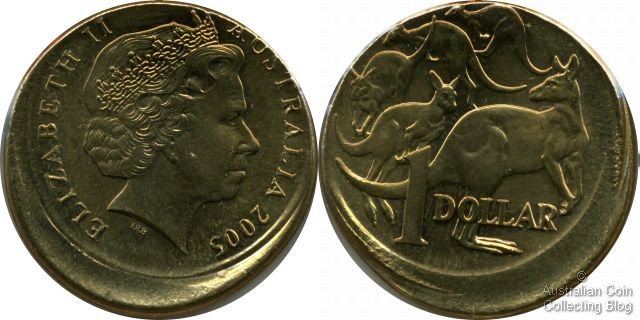 2005 $1 Mistrike pulled straight from a Security Bag
2005 $1 Mistrike pulled straight from a Security BagWe've recently discussed how new coins are handled and distributed from manufacture at the Royal Australian Mint through processing at the security companies and then delivery to clients such as banks and supermarkets. Based on these processes we're now able to discuss how manufacturing errors might be released into circulation or how they might be caught up in the system.
For bulk circulation coinage once the coins leave the coining press there are no processes for quality control to find any imperfect or error coins before leaving the Royal Australian Mint.
It's up to security companies who handle the bulk coin to "come across" any problem coins in the system. This is much easier with coin rolling machines as any coins of incorrect shape or size are quickly fed into a reject box and the system continues to operate.
With the batcher machine (explained in the previous article) which feeds the coins into bags a mistruck coin will stick onto the rail of the batcher. The machine ceases to run but as the operator opens the door the coin may just run into the small bag because the belt continues to move momentarily. Once the bags are sealed there are no other checks (except for the odd bag that is weight/face value checked) and the coin will happily pass into circulation. Is this how the dramatically double struck $2 coins passed into circulation?
The weights of new coins are a huge headache for security companies. The manual checks of the weights of the bagged new coins can differ dramatically. One dollar coins can often weigh somewhere between 8 and 9 grams when 9 grams should be the exact weight. This can escalate into 60 grams per $100 and then 6-8kg per pallet which is a 6% error rate. Not acceptable when you're talking about money! This is the result of poor quality blank manufacturing procedures at the factory who the RAM buys their coin blanks off, Poongsan in South Korea. We've seen mistakes that have originated from there with a one dollar coin passing through the system into circulation.....struck on a bimetal planchet!
If the problem coins are detected in these processes what happens next? Well if they aren't appropriated by staff or sent back to the RAM then they are sent interstate to a company which refunds the security company the Australian dollar equivalent or the scrap metal equivalent. This company still receives 1c and 2c pieces which are paid approximately double the face value for their copper content.
So it's really looking quite promising that on your next trip to the supermarket you could be heading home with a mistruck coin in your pocket!
Posted by harrisk at August 4, 2010 9:09 PM
Subscribe to our Newsletter


